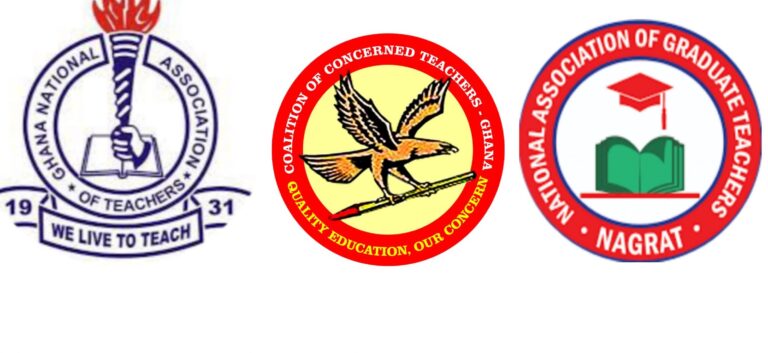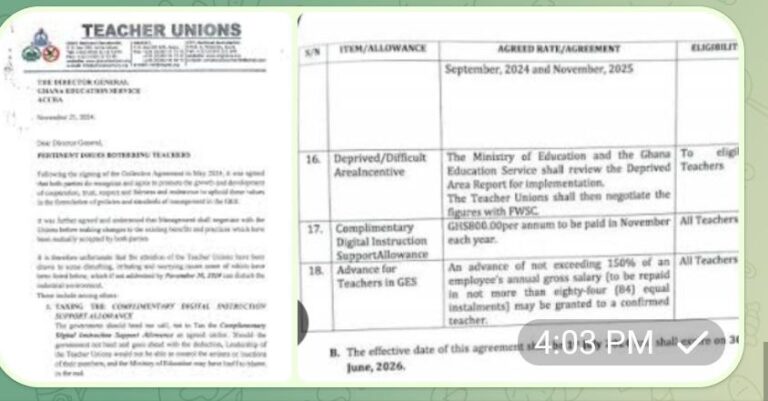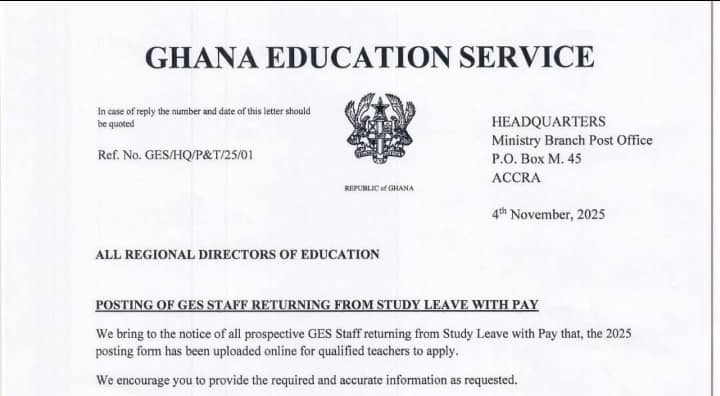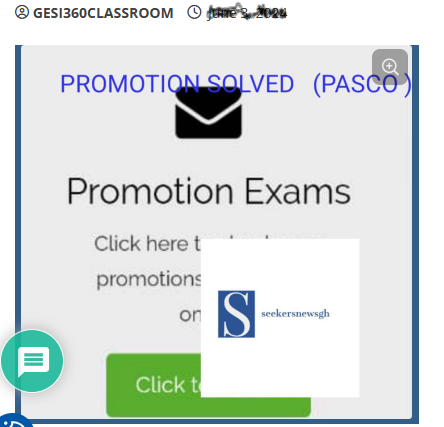
LAST YEARS PROMOTION QUESTIONS AND ANSWERS FOR ASSISTANT DIRECTOR II AD2
SECTION A (MULTIPLE CHOICE QUESTIONS AND ANSWERS)
INSTRUCTION: Answer all questions in this Section by circling the letter corresponding to the correct or best answer on your question paper.
1. In what year was the Ghana Education service (GES) established?
A. 1974
B. 1987
C. 1995
D. 2000
ANSWER: A- 1974
2. Which of the following is an example of intrinsic motivation?
A. Learning a new language out of interest
B. Participating in sports to win medals
C. Studying hard to avoid punishment
D. Working on a project for a reward
ANSWER: A-Learning a new language out of interest
3. Which of the following is a major goal of inclusive education?
A. To create specialized schools for students with disabilities
B. To eliminate standardized testing for all student with disabilities
C. To provide equal educational opportunities for all students
D. To separate students based on their abilities and disabilities
ANSWER: C- To provide equal educational opportunities for all students
4. Which of the following is a characteristics of a reliable assessment?
A. It is easy to administer among students
B. It is fair to all students and teachers
C. It measures what is intended to measure
D. It yields consistent results over time
ANSWER: D-It yields consistent results over time
5. Which of the following is not part of the membership of Ghana Education Service?
A. All the stakeholders in Education
B. Personnel of the Ghana Education Service pre- 1995
C. Persons that may be employed for the service
D. Teachers and non-teaching personnel in public tertiary educational institutions.
ANSWER: A- All the stakeholders in education
6. Which of the following is the core function of the Ghana Education Service(GES)?
A. Conducting managing national promotion examination
B. Developing and implementing tertiary education curriculum
C. Managing and implementing pre- tertiary educational policies
D. Overseeing basic, secondary and university education
ANSWER: C- Managing and implementing pre- tertiary educational policies
7. Which type of assessment is designed to measure a student’s performance against a set of criteria or learning standards?
A. Criterion-referenced assessment
B. Diagnostic assessment
C. Norm-referenced assessment
D. Summative assessment
ANSWER: A- Criterion-referenced assessment
8. Which of the following describes a portfolio assessment?
A. A Collection of student work that demonstrate learning progress and achievements
B. A multiple-choice test covering all subjects an knowledge areas
C. A standardized test that is given at the end of the year
D. An oral examination to assess the knowledge and skills of the students
ANSWER: A- A Collection of student work that demonstrate learning progress and achievements
9. Which of the following strategies can help in managing a diverse classroom effectively.
A. Allowing students to work independently at all times
B. Differentiating instruction to meet varied learning needs
C. Treating all students equally regardless of their needs
D. Using a one-size-fits all teaching approach
ANSWER: B- Differentiating instruction to meet varied needs
10. Which type of classroom management focuses on student teacher collaboration and mutual respect?
A. Assertive discipline
B. Behavioural modification
C. Positive behaviour support
D. Transactional analysis.
ANSWER: D- Transactional analysis
11. Which of the following is an essential component of effective management?
A. Allowing students to set their own rules
B. Establishing clear rules and routines
C. Ignoring student misbehaviour
D. Using corporal punishment
ANSWER: B- Establishing clear rules and routines
12. Which of the following is a form of positive reinforcement?
A. Giving a student extra homework
B. Ignoring a students efforts
C. Praising a student for a good behaviour
D. Removing a previlege for a bad behaviour
ANSWER: C- Praising a student for a good behaviour
13. Which learning theory emphasizes the importance of social interactions in learning?
A. Behaviourism
B. Cognitivism
C. Constructivism
D. Humanism
ANSWER: C- Constructivism
14. Which theory of learning emphasizes the role of mental processes in understanding how people learn?
A. Behaviourism
B. Cognitivism
C. Humanism
D. Social constructivism
ANSWER: B-Cognitivism
15. What is the main purpose of using a seating arrangement in classroom management?
A. To allow students to sit with their friends
B. To establish authority and autonomy
C. To make the classroom look organized
D. To minimize disruptions and enhance learning
ANSWER: D- To minimize disruptions and enhance learning
16. Which classroom management technique involves giving students choices to enhance their autonomy and responsibility?
A. Assertive discipline
B. Authoritative teaching
C. Democratic teaching
D. Permissive teaching
ANSWER: C- Democratic teaching
17. The mission of the ministry of Education (MoE) is to provide …………
A. Compulsory technical education
B. Employment for graduates
C. Free education for all
D. Inclusive and equitable education
ANSWER: D- inclusive and equitable education
18. The education Strategic Plan (ESP) of the Ministry of Education aims to …………
A. Build more senior high schools
B. Expand higher education access
C. Increase teacher salaries
D. Provide equitable access to quality education
ANSWER: D- provide equitable access to quality education
19. Which Act governs the establishment and operations of the Ghana Educational Service?
A. Education Act 2008
B. Ghana Education Act 1995
C. Public Service Act 2001
D. Teachers Service Act 1990
ANSWER: B- The Ghana Education Act 1995
20. Which of the following agencies of the Ministry of Education is responsible for implementing policies and programmes related to higher education?
A. Complementary Education Agency
B. Ghana Library Board Authority
C. Ghana Tertiary Education Commission
D. National Commission for Civic Education
ANSWER: C- Ghana Tertiary Education Commission (GTEC)
21. Lev Vygotsky’s concept of the Zone of the Proximal Development (ZPD) refers to
A. Skills that a leaner can perform independently
B. Tasks a learner cannot accomplish, even with assistance
C. The difference between what a learner can do with and without help
D. The total range of a learner’s abilities, competencies and skills
ANSWER: C- The difference between what a learner can do with and without help
22. Which of the following is an example of extrinsic motivation?
A. A student helping a friend because they care about them
B. A student participating in class activities because they find the topic interesting
C. A student reading a book because they enjoy reading
D. A student studying hard in order to receive a scholarship
ANSWER: D- A student studying hard in order to receive a scholarship
READ THE FOLLOWING AND ANSWER THE QUESTIONS 23 TO 27.
Mr. Adom, a teacher at a junior high school in Accra, uses effective classroom management techniques. He establishes clear rules and routines from the first day and involves students in creating a class agreement. He uses praise and rewards to encourage good behaviour and adopts a democratic teaching style. Mr. Adom use various instructional strategies like group work and multimedia resources. He addresses conflicts promptly and fairly, promoting respect and cooperation.
His approach results in a environment.
23. What strategies does Mr. Adom use to maintain order?
A. Allowing students rule making
B. Employing multimedia resources
C. Establishing clear rules
D. Using praise and rewards
ANSWER: C- Establishing clear rules
24. How does Mr. Adom encourage good behaviour?
A. Allowing student rule-making
B. Employing multimedia resources
C. Establishing clear rules
D. Using praise and rewards
ANSWER: D- Using praise and rewards
25. Why does Mr. Adom use a democratic teaching style?
A. To build learner’s collaborative skills
B. To motivate learners to achieve their learning goals
C. To promote good behaviour among learners
D. To reach consensus among learners
ANSWER: A- To build learner’s collaborative skills
26. Why does Mr. Adom uses group work?
A. To build learners collaborative skills
B. To motivate learners to achieve their learning goals
C. To promote good behaviour among learners
D. To reach consensus among learners
ANSWER: A- To build learners collaborative skills
27. How does Mr. Adom handle conflicts?
A. He addresses them impartially
B. He ignores them completely
C. He lets students resolve them
D. He sends to the principal for redress
ANSWER: A- He addresses them impartially
READ THE FOLLOWING PASSAGE AND ANSWER THE QUESTIONS 28 TO 31
Mrs. Agyeman, a primary school teacher in Kumasi, applies various learning theories. She uses Vygosky’s social constructivists theory by encouraging collaborative learning in small groups. She designs age-appropriate task based on Piaget’s cognitive development theory. She uses scaffolding to provide support, reducing this support as students gain independence. Incorporating Gardner’s Multiple intelligences theory, she creates activities for different intelligences. Using skinner’s operant conditioning theory, she rewards positive behaviour and effort. This approach ensures her students learn effectively and develop critical thinking skills.
28. Which of the theories involves collaborative learning?
A. Behaviourism
B. Cognitivism
C. Multiple intelligence
D. Social constructivism
ANSWER: D- Social constructivism
29. From the passage, Mrs Agyeman uses Piaget’s theory to ensure that
A. Individual differences are taken care of
B. Instruction is tailored to needs of learners
C. Tasks are appreciate to the ages of learners
D. Teaching and learning activities are well-implemented
ANSWER: A- Individual differences are taken care of
30. Scaffolding in teaching involves ……….
A. Issuing direct instruction
B. Making students independent
C. Providing gradual support
D. Undertaking group projects
ANSWER: C-Providing gradual support
Follow us on WhatsApp for more updates: CLICK HERE
31. Form the passage, Mrs. Aagyeman uses multiple intelligences theory to ensure that…………….
A. Individual differences are taken care of
B. Instruction is tailored to the needs of intelligent learners
C. Tasks are appropriate to the ages of learners
D. Teaching and learning activities are well-implemented
ANSWER: C- Tasks are appropriate to the ages of learners
32. Which approach to classroom management focuses on identifying and reinforcing appropriate behaviours?
A. Cognitive behavioural approach
B. Eclectic approach
C. Positive behavioural interventions and supports
D. Psychoanalytic approach
ANSWER: C- Positive behavioural interventions and supports
33. Which type of assessment is typically used to identify students strengths and weaknesses before instruction begins?
A. Benchmark assessment
B. Diagnostic assessment
C. Formative assessment
D. Summative assessment
ANSWER: B- Diagnostic assessment
34. Which of the following is an example of a formative assessment?
A. Classroom discussion
B. End-of-term exam
C. Final project
D. Standardized test
ANSWER: A-Classroom discussion
35. What does the high -stakes test refer to?
A. A test that covers a wide range of subject areas
B. A test that has significant consequences for the test taker
C. A test that is administered frequently in the classroom
D. A test that is expensive to administer in the classroom
ANSWER: B- A test that has significant consequences for the test taker
36. Rubrics are used in educational assessment to
A. Conduct standardized testing for all students
B. Evaluate student performance based on specific criteria
C. Measure physical fitness of all students in the school
D. Record attendance and participation in the school
ANSWER: B- Evaluate student performance based on specific criteria
37. The Sustainable Development Goal (SDG) 4 focuses on all the following except
A. Ensuring equitable education
B. Ensuring free education
C. Ensuring quality education
D. Promoting life-long learning
ANSWER: B- Ensuring free education
38. Which of the following best describes the purpose of the flipped classroom model?
A. To eliminate the need for textbooks and provide more homework for students
B. To have students engage with learning material prior to classroom engagements
C. To increase teacher- directed lessons to provide less homework for students
D. To provide more homework for students and increase teacher directed lesson
ANSWER: B- To have students engage with learning material prior to classroom engagements
39. In the context of contemporary education, what does 21st century skills refer to?
A. Critical thinking, communication, collaboration and creativity
B. Knowledge and skills related to information technology only
C. Traditional academic skills, knowledge and competencies
D. Vocational and technical skills and knowledge
ANSWER: A- Critical thinking, communication, collaboration and creativity
40. Which of the following strategies can help reduce teacher burnout?
A. Increasing administrative tasks for teachers
B. Increasing class sizes and attendance
C. Providing professional development and support
D. Reducing teachers’ planning time
ANSWER: C- Providing professional development and support
41. Which contemporary issue in education is mostly closely associated with the rapid advancement of technology?
A. Digital divide
B. School infrastructure
C. Standardized testing
D. Traditional teaching method
ANSWER: A- Digital divide
42. Global citizenship aims to:
A. Focus soley on local community issues and personal awareness
B. Foster an understanding of global issues and intercultural awareness
C. Limit students exposure to international perspectives
D. Promote nationalistic ideals, values and practices
ANSWER: B- Foster an understanding of global issues and intercultural awareness
43. In bloom’s taxonomy, which level involves the highest order of thinking?
A. Analysing
B. Applying
C. Creating
D. Understanding
ANSWER: C- Creating
44. John Dewey is most closely associated with which educational philosophy?
A. Essentialism
B. Perennialism
C. progressivism
D. Reconstruction
ANSWER: C- Progressivism
45. Which of the following is a characteristic of a well-manage classroom?
A. Frequent teacher reprimands
B. High levels of student engagement
C. Inconsistent application of rules
D. Structured lesson plans
ANSWER: B- high levels of student engagement
46. Which principle of learning suggests that practice is necessary for mastering skills?
A. Law of effect
B. Law of exercise
C. Law of primacy
D. Law of readiness
ANSWER: B-Law of exercise
47. Constructivist teaching strategies often include
A. Project-based learning
B. Role of memorization
C. Standardized testing
D. Teacher-centered lectures
ANSWER: A-Project-based learning
48. In Maslow’s hierarchy of needs which need must be met first?
A. Esteem
B. Physiological
C. Safety
D. Self-actualization
ANSWER: B- Physiological
49. A test that accurately measures what it is supposed to measure is said to have………
A. Fairness
B. Objectives
C. Reliability
D. Validity
ANSWER: D- Validity
50. Which of the following is the primary purpose of formative assessment?
A. To assign final grades to students performance
B. To compare students performance to national standards
C. To evaluate the effectiveness of the educational programme
D. To provide ongoing feedback to improve teaching and learning
ANSWER: D- To provide ongoing feedback to improve teaching and learning
Follow us on WhatsApp for more updates: CLICK HERE
SECTION B
TRUE OR FALSE QUESTIONS
INSTRUCTION: Answer all questions in this section by circling the letter corresponding to the correct or best answer on your question paper.
51. The digital divide refers to the gap between students with access to modern students with communication technology and those without access.
A. True
B. False
ANSWER: A- True
52. STEM education includes the study of science, Technology, English and Mathematics.
A True
B.False
ANSWER: B- False
53. A flipped classroom model typically involves students doing homework in class and watching lectures at home.
A. True
B. False
ANSWER: A- True
54. In Ghana, 21st- Century skills are limited to technical and vocational skills.
A. True
B. False
ANSWER: B- False
55. One of the challenges of the COVID-19 pandemic for educational systems has been the need to transition to remote learning solutions.
A. True
B. False
ANSWER: A- True
56. The Ghana Education Service (GES) was established as part of the Public Service of Ghana in 1974.
A. True
B. False
ANSWER: A- True
57. The Ministry of Education (MoE) is soley responsible for higher education in Ghana.
C. True
D. False
ANSWER: B- False
58. The Director General is the head of the Ghana Education Service.
A. True
B. False
ANSWER: A- True
59. The National Council for Curriculum and Assessment (NaCCA) is responsible for developing the curriculum for tertiary education in Ghana.
A. True
B. False
ANSWER: B- False
60. The Free Compulsory Universal Basic Education (FCUBE) policy aims to provide free tertiary education in Ghana.
A. True
B. False
ANSWER: B- False
61. The Education Strategic Plan (ESP) aims provide equitable access to quality education for all Ghanaians.
A. True
B. False
ANSWER: A- True
62. John Dewey advocated for a traditional, teacher-centered approach to education.
A. True
B. False
ANSWER: B- False
63. According to Maslow’s Hierarchy, self – actualization is the highest level of need.
A. True
B. False
ANSWER: A- True
64. Behaviourism emphasizes the role of internal mental states in learning.
A. True
B. False
ANSWER: B- False
65. Constructivist teaching often involves hands-on, experiential learning activities.
A. True
B. False
ANSWER: A- True
66. Extrinsic motivation is driven by external rewards or avoidance of punishment.
A. True
B. False
ANSWER: A- True
67. Positive reinforcement can be used to encourage desired behaviours in students.
A. True
B. False
ANSWER: A- True
68. Cognitivism focuses on observable behaviours rather than mental processes.
A. True
B. False
ANSWER: B- False
69. An authoritative classroom management style combines high expectations with support and encouragement.
A. True
B. False
ANSWER: A- True
70. Formative assessment are used primarily to evaluate a completed instructional programme.
A. True
B. False
ANSWER: B- False
71. Norm-referenced assessments compare a student’s performance to a pre- determined standard or Criterion.
A. True
B. False
ANSWER: B- False
72. A valid assessment accurately measures what it is intended to measure.
A. True
B. False
ANSWER: A- True
73. Summative assessment are typically administered during the instructional process to provide immediate feedback.
A. True
B. False
ANSWER: B- False
74. Diagnostic assessments help identify Student’s prior knowledge and misconceptions before instruction begins.
A. True
B. False
ANSWER: A- True
75. Inclusive Education seeks to provide equal education opportunities for all students regardless of their abilities or disabilities.
A. True
B. False
ANSWER: A- True
Follow us on WhatsApp for more updates:
Follow us on WhatsApp for more updates: CLICK HERE
Seekers Consult
Contact Us for Your Study Abroad Journey
We search for schools and check available scholarships for you
Contact: 0550414552 / 0362297079
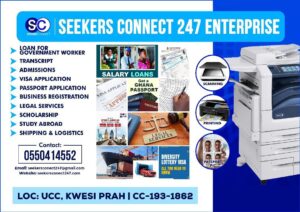
Loan for government workers
Transcript Application
English Proficiency
Recommendation letter
Project work/thesis for undergraduate, master’s, and PhD students.
Apply for Affidavit, Gazette instantly
Passport and Visa Applications
All other Internet Services


